North Carolina has a diverse geography broken down into 3 main areas. These are the Piedmont Plateau, the Appalachian Mountains, and the Atlantic Coastal Plain. This is good news, as it means that you can see a variety of birds no matter where in North Carolina you reside.
Today we are going to highlight a number of these feathered stars and let you know how to lure them or where you can go to spot them.
Let’s talk about the popular backyard birds of North Carolina!
3 Categories – 469 Birds
North Carolina has a large avian population at approximately 469 birds strong. This is great for birdwatchers as you have a number of feathered friends you might get to see. In order to make things a little easier, we will break down the birds we are listing today in seasonal categories as follows:
- Year-round Resident birds
- Birds of Spring, Summer, and Early Fall
- Fall and Winter Birds
North Carolina’s Year-round Resident Birds
All year round these birds are playing, breeding, and foraging and will a watchful eye and a cleverly loaded feeder you can take advantage and get a glimpse of Nature’s feathered stars. The birds we’ll list below are visible all throughout the year and some of them are stunning. Take a look at these year-round residents of North Carolina:
- Eastern Bluebird
- Carolina Chickadee
- Eastern Screech Owl
- Pileated Woodpecker
- Carolina Wren
Eastern Bluebird – Sialia sialis
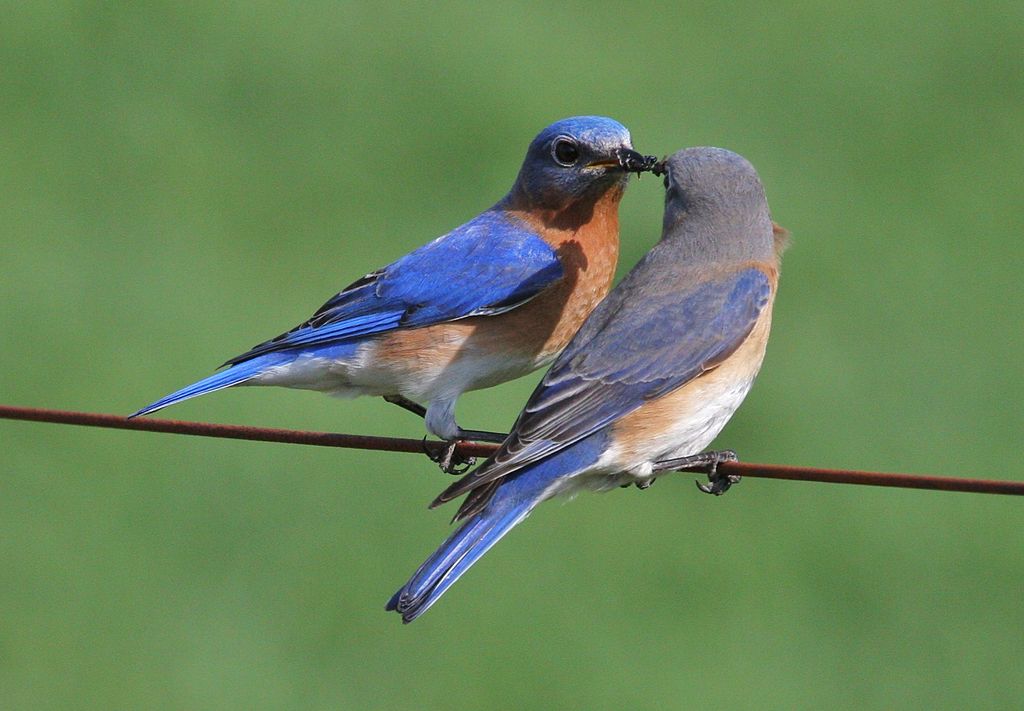
Coloration and Markings: These pretty little thrushes have some coloration differences based on gender. The males have long, deep blue wings with black tips and short blue tails with black accent marks. They have white underbellies and their breast and throat is a deep rust color. Facially, they are also blue and they have short, gray bills with a slight curve to them. Females are much paler and have gray heads with some white on the throat and a much more subdued rust coloration.
Size: These birds measure in at 6.3 – 8.3 inches with wingspans of approximately 9.8 to 12.6 inches.
Habitat: These birds like meadows but they are also fond of nesting boxes, so you can see them in residential areas quite often.
Diet: Eastern Bluebirds will visit your feeder but not for the standard fare of seeds and suet. Mealworms can tempt them to visit your feeder.
Carolina Chickadee – Poecile carolinensis
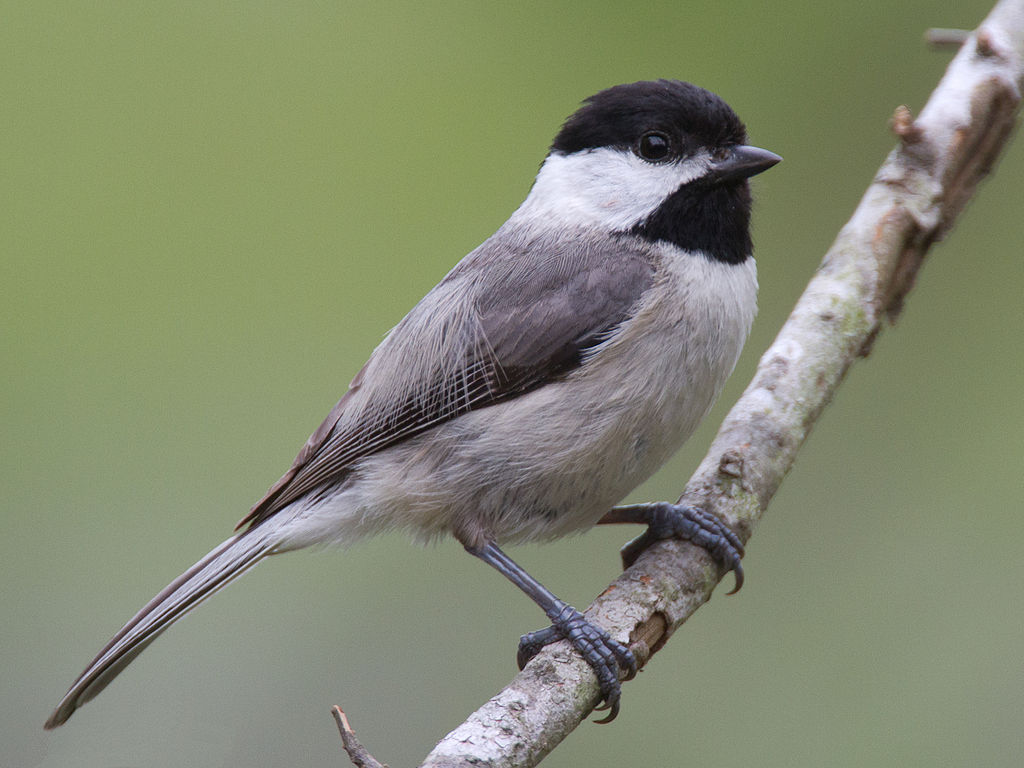
Coloration and Markings: Carolina Chickadees have light gray wings and and medium sized gray tails. Their breast and underbelly are gray as well, with splotches of white mixed in. Facially, they have black throats and chin and a black cap above the beak with a wide, white stripe which starts at the beak and continues under the eye to the back of the neck.
Size: These are tiny birds, which measure 3.9 – 4.7 inches in length and with wingspans of 5.9 to 7.9 inches.
Habitat: These birds love forests but they are just as enamored with residential areas, provided that there are some tall trees around.
Diet: Crushed peanuts, sunflower seeds, and suet are favorites of this bird and can lure them into visiting your feeder. They are also fond of nesting boxes stuffed with wood shavings and setting up one of these might lure a breeding pair into your backyard!
Eastern Screech Owl – Megascops asio

Coloration and Markings: Masters of camouflage, these birds have grey breasts and underbellies with some spots of brown. These patterns let them blend in almost perfectly in the nooks and branches of trees. Facially, they have banded brown ear tufts and a brown triangle on their forehead, along with distinctive brown tufts on both sides of their heads.
Size: These owls are tiny, about the size of a pint glass. They measure in at 6.3 – 9.8 inches and have wingspans of 18.9 to 24 inches.
Habitat: These birds love trees and it doesn’t matter if they are in a forest or the suburbs, so if you are lucky and hear some trilling at night then you might just have a Screeh Owl in your backyard!
Diet: While you won’t be able to provide them with their usual live diet, you might be interested to know that you can still lure them into your yard with a birdbath or a nesting box. These birds eat rodents and insects and as such, the only other strategy is to cultivate more of these. You could make a woodpile, for instance, but otherwise the nesting box and birdbath are going to be your best luring strategy.
Pileated Woodpecker – Dryocopus pileatus

Coloration and Markings: These woodpeckers are quite striking, with black underbelly and breast and with a white crescent under their wings which extends slightly on the upper breast. Other than this, they have black bodies with some slight gray to them and long black tails. Facially, they have long, black bills and a red slash that extends from bill to cheek. Underneath and above this slash this bird’s face is white, with a stripe on each side of the next going from cheek to shoulder. Across this bird’s eye is a black ‘bandit’s mask’ and above this, a small stripe of white and a stunning red crest.
Size: This is a large woodpecker, measuring 15.8 – 19.3 inches with a wingspan of 26 to 29.5 inches.
Habitat: These birds can be found in just about any type of forest, though they prefer to areas with large dead trees. They do come into residential areas, provided that there are trees in the area as well.
Diet: These birds will come to your feeder if you have suet, so stock up and perhaps you’ll get a Pileated Woodpecker’s attention!
Carolina Wren – Thryothorus ludovicianus

Coloration and Markings: These birds have reddish-brown upper bodies with subtle, banded patterns made from tiny black and white dots on their wings and their medium sized, perky tails. Their underbellies are a soft orange and yellow mix. Facially, these birds have white chins and the white extends to the base of the throat. They have noticeably curved black or gray bills, with a gray line under the eye and a long, white eyebrow above it which extends to the back of the bird’s head. You’ll also notice a splotch of white behind the cheek and reddish-brown on the top of the head. These are pretty little birds.
Size: Measuring in at 4.7 – 5.5 inches, these birds have a wingspan of approximately 11.4 inches.
Habitat: These birds love the forest and the suburbs equally, preferring brush and other dense vegetation.
Diet: Carolina Wrens love Suet and it’s especially in demand in the Winter. Add some to your feeder to help them out and to lure them into your backyard.
North Carolina’s Birds of Spring, Summer, and Early Fall
North Carolina can get cold in the Winter, dropping down to 10-12 Fahrenheit (7.2 degrees Celsius) and as such, a number of birds take a little vacation during the winter time and return when it begins to warm up. Here are North Carolina’s birds of Spring, Summer, and Early Fall to watch for once the temperature begins rising again:
- Song Sparrow
- House Finch
- Tufted Titmouse
- Wood Thrush
- Eastern Phoebe
Song Sparrow – Melospiza melodia
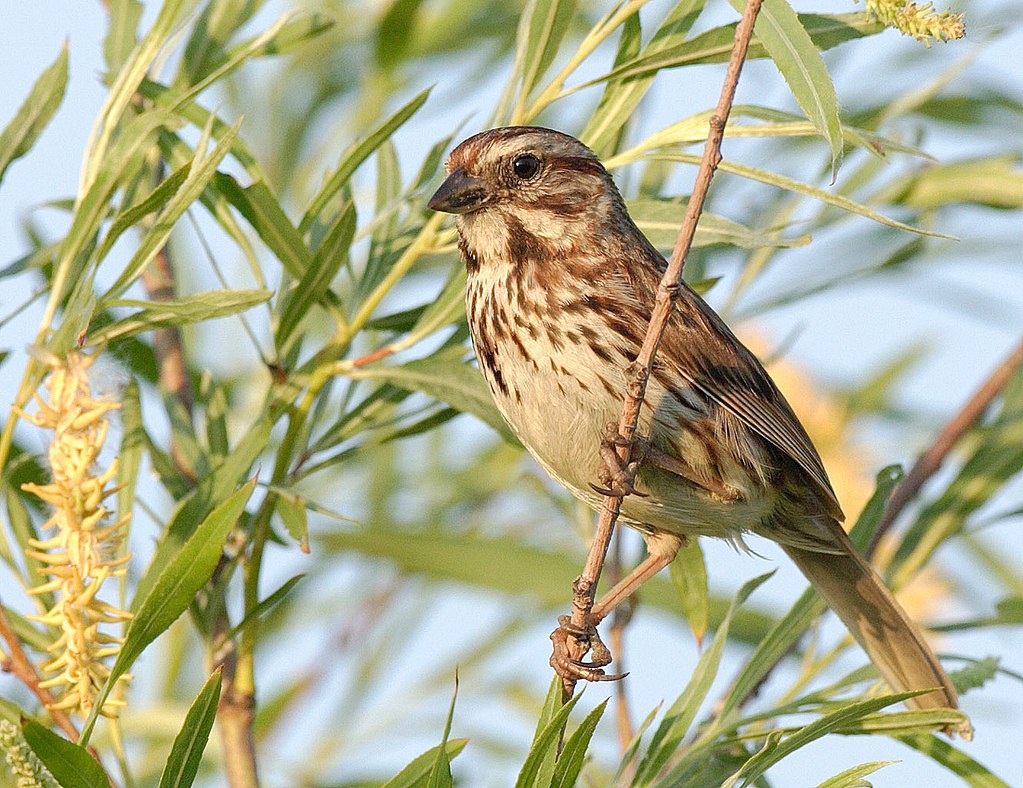
Coloration and Markings: Song Sparrows are lovely, with brown feathers which bear streaks of gray along their wings, breast, and underbelly. They have short, brown tails and facially the gray is more striking, with a large gray stripe above the eye going to the back of the head and a smaller gray stripe underneath the eye which goes to the back of the neck. A small white stripe goes from the base of the Sparrow’s tiny black bill to the cheek and curves at an angle across the face. They are quite distinctive and once you recognize one you’ll know them easily on sight.
Size: Song Sparrows measure 4.7 -67 inches in length and have a wingspan of 7.1 to 9.4 inches.
Habitat: These birds love branches and brush and don’t be surprised if you see them hopping on the ground, as this is normal foraging activity for this Sparrow.
Diet: Song sparrows are fond of seeds, berries, and grains. Load up your feeder with these and you might just lure a few Song Sparrows to visit and be sure to scatter some on the ground. They like to hop under feeders sometimes to forage for dropped seed.
House Finch – Haemorhous mexicanus
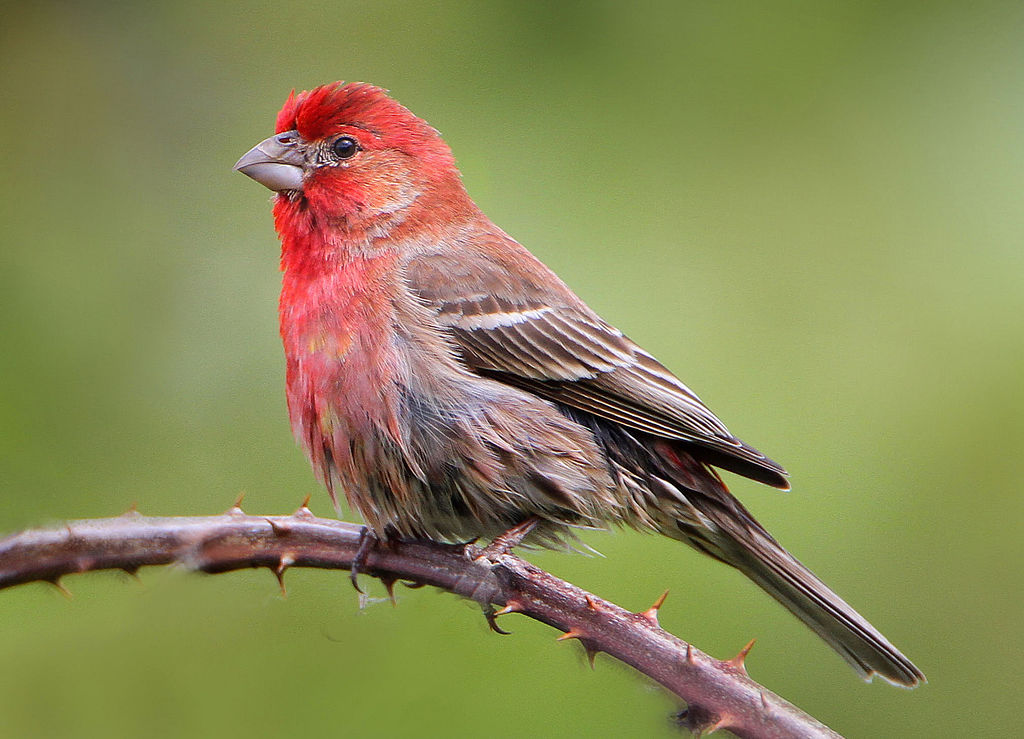
Coloration and Markings: As with many birds, the males get the really stunning plumage. The male House Finch has a deep crimson breast and a gray underbelly, coupled with wings, back, and tail which are brown streaked with black. They really take your breath away. Facially, these birds have red faces with some gray lines curving from the back of the bill to under the cheek and to the back of the neck. Their bills are short but stout, great at demolishing seeds. The females, by contrast, are streaked brown all over, with no trace of the red, but once you know the beak you can spot them fairly easily.
Size: These birds are small, measuring in at 5.1 – 5.5 inches in length and with wingspans of 7.9 to 9.8 inches.
Habitat: These birds love the forest edge but you also see the in inhabited areas, such as parks, farms, and the suburbs.
Diet: House Finches love Black Oil Sunflower seeds but get small ones, these are little birds. Don’t be surprised if they bring friends. These birds love to travel in large flocks so put some extra seed out, just in case, and prepare for a little chirping enchantment.
Tufted Titmouse – Baeolophus bicolor
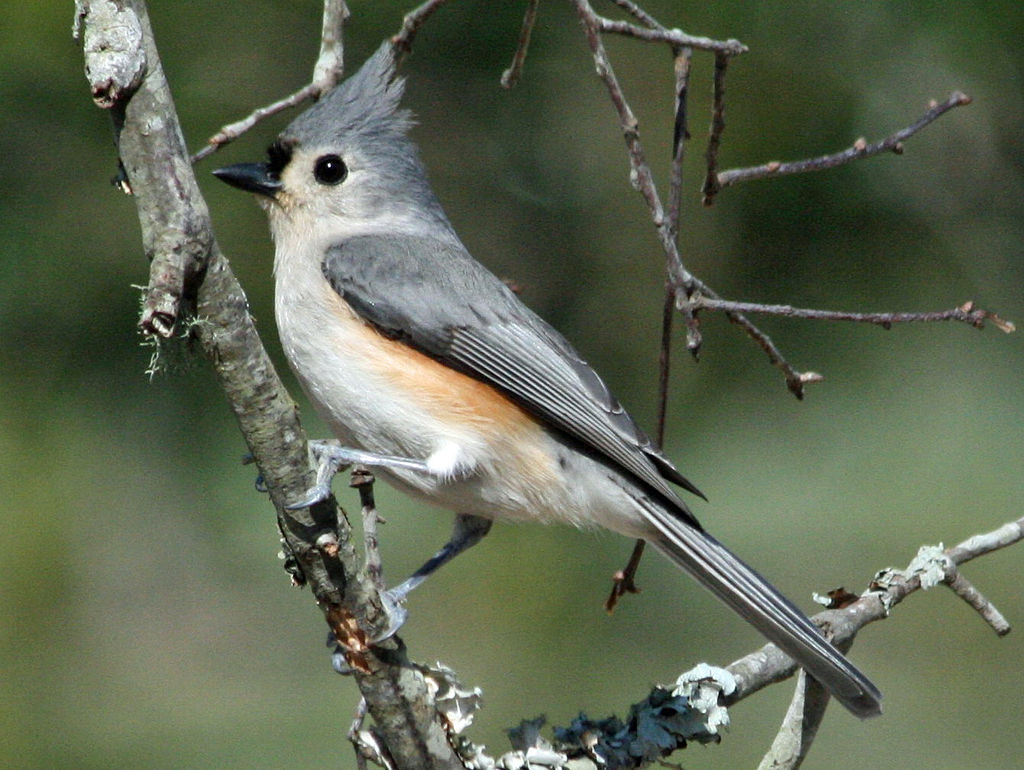
Coloration and Markings: These are good looking birds. They have a silver, almost blue color to their wings and tail and a white breast with splashes of peach close to the belly and by the wings. Facially, they have white heads with blue crests and splashes of blue going down from the crest, behind the eye, and to the back of the neck. They have short, curved bills and a distinctive black splotch right over the bill.
Size: The Tufted Titmouse has a length of 5.5 – 6.3 inches and a wingspan of 7.9 to 10.2 inches.
Habitat: These birds love deciduous and evergreen forests but they also frequent orchards, gardens, and backyards as well.
Diet: The Tufted Titmouse will gladly eat Suet and Peanuts but they reallygo nuts for Sunflower seeds. Stock up on some Black Oil Sunflower seeds, load up the feeder, and keep an eye out for them.
Wood Thrush – Hylocichla mustelina

Coloration and Markings: Wood Thrushes are instantly recognizable, with their upper bodies being a warm, rich mix of red and brown while their breast and underbelly is paper-white with black spots dotted all over. Facially, look for the distinctive white ring around the eye, yellow bills with black-tip on the upper portion of the beak, and a red-brown crown and neck next to a white face speckled with smaller black dots.
Size: These birds measure in at 7.5 – 8.3 inches from tip to tail and with typical wingspans around 11.8 to 13.4 inches.
Habitat: These birds love large forests of any type and sometimes forage in fallen leaves. If there is a woodlot nearby you might be able to spot one if you are lucky but this is a very shy bird. You’ll need those binoculars.
Diet: These birds love to forage on the ground but typically like to hide in wooded areas. If you have a large backyard with trees you might get lucky if you scatter some seeds on the ground but you are more likely to hear these birds nearby than see them in your yard.
Eastern Phoebe – Sayornis phoebe

Coloration and Markings: These birds are brown and gray, with white line-accents in the wings, white breast and underbelly, and medium sized tails. Their breast and belly sometimes look a bit yellow in the fall and facially these birds have white chins with a white line going under the cheek and thinning towards the shoulders. They have a line of gray starting under the beak and running to the back while the rest of the head is black with slight hints of gray. They have medium-length, thin black bills.
Size: Eastern Phoebes are generally 5.5 – 6.7 inches in length and have wingspans around 10.2 to 11 inches.
Habitat: These birds love the woods, parks, and backyards and they like to nest near buildings so they aren’t as shy as some birds.
Diet: These birds like insects and berries. In particular, American Elderberries in your feeder might just get their attention. They are also tempted by nesting boxes so make sure to have a few in your yard.
North Carolina’s Fall and Winter Birds
Some North Carolina birds are ‘hardcore’ and when things get chilly they get to foraging extra food and brace themselves for the cold. Some North Carolina Winter-residents to watch for are as follows:
- Hermit Thrush
- Yellow-bellied Sapsucker
- White-throated Sparrow
- Black-eyed Junco
- Great Horned Owl
Hermit Thrush – Catharus guttatus

Coloration and Markings: These birds have a soft and smooth brown color to their wings and a white breast and underbelly, with the breast showing distinctive black spotting. Facially, these birds have the white, spotted pattern under their bills extending under the cheek and almost to the back of thehead, with brown on top and a spiderweb-thin eye ring. They have long, straight black bills.
Size: These birds range from 5.7 – 7.1 inches in length and typically have wingspans of 9.8 to 11.4 inches.
Habitat: These birds like to forage in logs, leaf piles, and thick brush.
Diet: While these birds are too shy for feeders, they love berries. If you have some Blackberries or other berries growing in your garden then they might visit. The odds increase if you have some trees in your backyard.
Yellow-bellied Sapsucker – Sphyrapicus varius
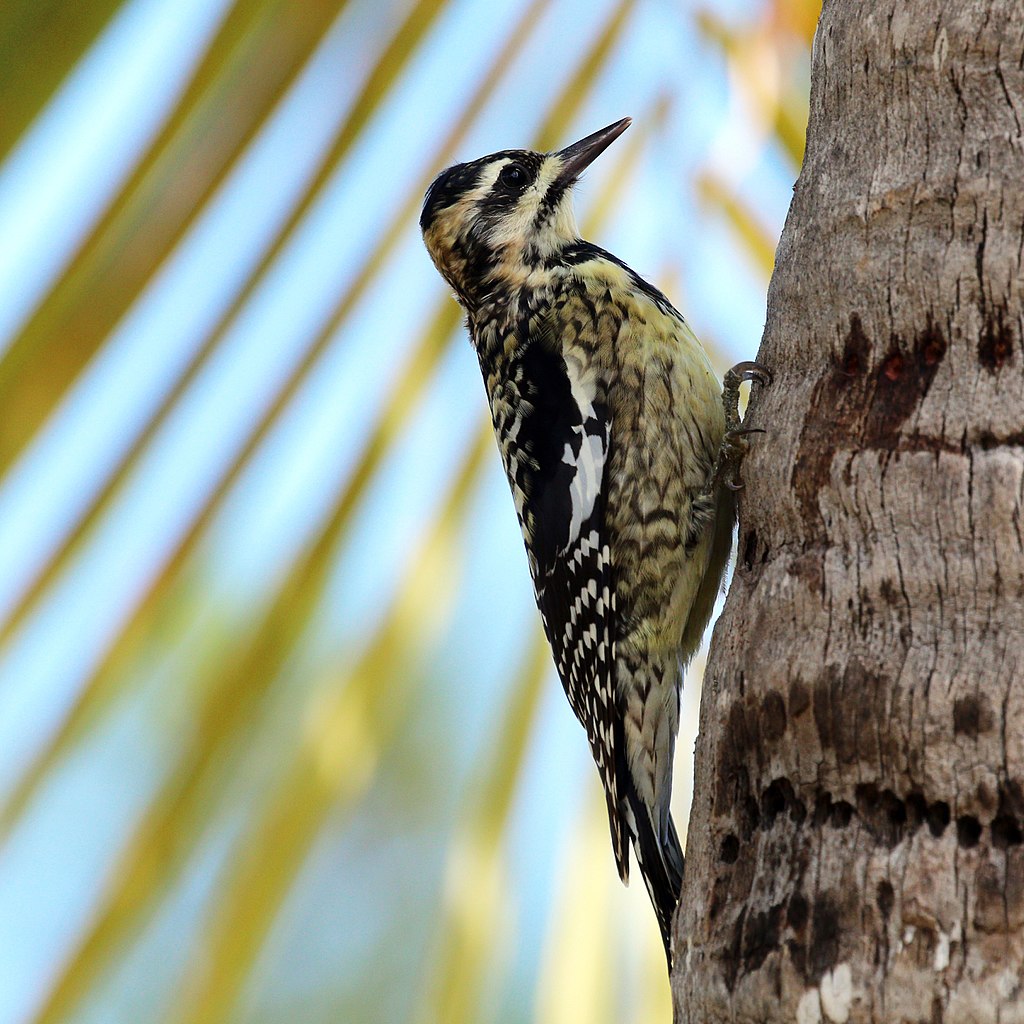
Coloration and Markings:
Size: Yellow-bellied Sapsuckers measure in at 7.1 to 8.7 inches from head to tail and have wingspans of 13.4 to 15.8 inches.
Habitat: Deciduous forests, generally around 6500 feet in elevation, though they do visit feeders from time to time. They prefer to Winter in the woods but you can occasionally see a ‘straggler’ in your yard.
Diet: These birds are shy but Suet in your feeder can sometimes tempt them to visit. As the name implies, if you have Maple or other sap-bearing trees then you might just get to see them at work, pecking away for that delicious sap.
White-throated Sparrow – Zonotrichia albicollis
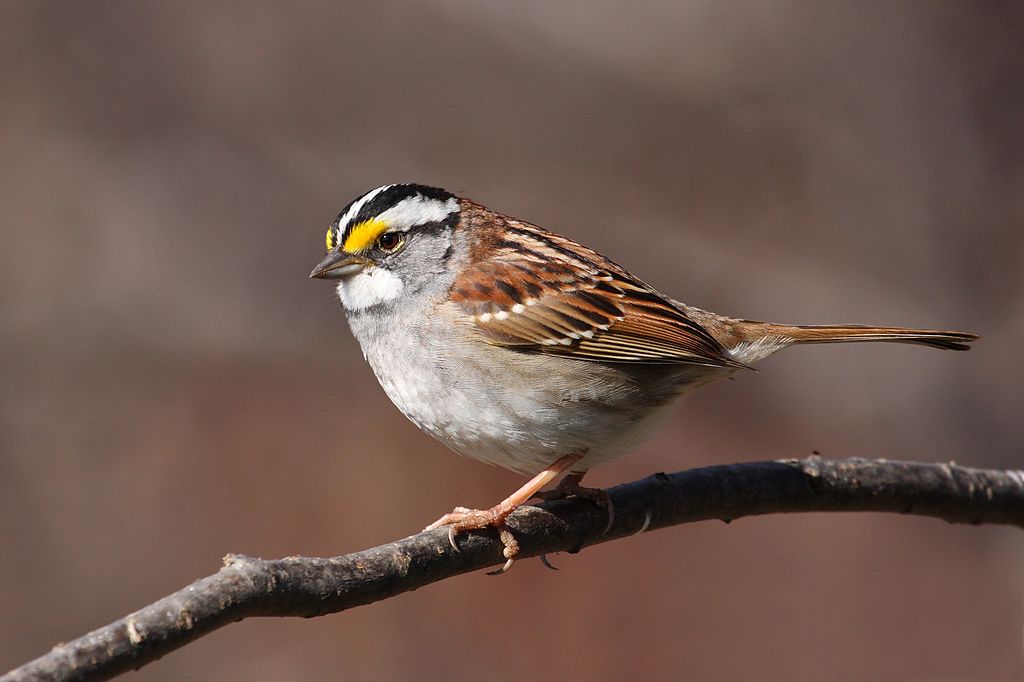
Coloration and Markings: These birds have brown wings with white highlights and long, brown tails. Their breast and underbelly is a handsome mix of gray and white with tan borders. Facially these birds are very recognizable, with a ‘skunk cap’ of black with a white center stripe, gray cheeks, and a white chin with the remaining lower half of the face being gray. Above their small, sharp, and slightly curved bills they have a yellow splotch that extends just above the eye before turning to a large white ‘eyebrow’ that extends to the back of the head. Finally, there is a thin, black stripe that crossed the eye to the back of the neck.
Size: White-throated sparrows are approximately 6.3 – 7.1 inches in length with a wingspan of 7.9 to 9.1 inches.
Habitat: These birds like the forest’s edge as well as brush, thickets, and even weedy fields. They are also attracted to water (get that birdbath ready!) and are no strangers to parks or backyards, either.
Diet: These birds love all types of seeds and will happily visit your feeder if you’ve left a little something out for them.
Black-eyed Junco – Junco hyemalis

Coloration and Markings: Dark-eyed Juncos typically have dark gray (sometimes brown) wings and the same coloration on the tops of their long tails, while their breast, underbelly, and the bottoms the tails are a contrasting white. Facially, they have Gray or brown heads and sharp, stout pink bills. Some coloration differences are seen between regions but typically the contrasting colors are quite smoothly separated, giving the Junco its distinctive look.
Size: Juncos are not very large, with a length of 5.5 – 6.3 inches and wingspans of 7.1 to 9.8 inches.
Habitat: These birds love coniferous woods but they are also seen in fields, parks, and backyards.
Diet: Dried insects, berries, and Sunflower or other seeds will tempt a visiting Junco to take a closer look. They aren’t shy about visiting feeders once they know that there are snacks waiting.
Great Horned Owl – Bubo virginianus

Coloration and Markings: Great Horned Owls have grayish-brown bodies that make them tricky to spot in the trees. Facially, however, they have distinct red-brown, almost heart-shaped faces outlined in black on the edges and with a white patch on their throat. They have large dark brown to black ‘ear tufts’ outlined in gray and the tops of their heads are silver-gray, triangulating down between the eyes to their small, powerful beaks.
Size: These are big owls, measuring in at 18.1 – 24.8 inches in length! They have large wingspans, approximately 39.8 inches to 57.1 inches from wingtip to wingtip.
Habitat: These birds love the woods but it’s not uncommon to see them in parks or even the suburbs.
Diet: These owls eat small mammals so unless you have a woodpile that attracts rodents (which you’d better not make if you have a garden!) then your best bet to lure them is a nesting box.
Supporting cast (Other Backyard Birds of North Carolina That Might Pay You a Visit)
While our primary year-round birds are certainly stars they are not the only birds that you can see throughout the year in North Carolina. Here are a few other year-round residents that can also add a little delight to your day in any season:
- American Goldfinch
- Eastern Towhee
- American Oystercatcher
- Red-tailed Hawk
- Turkey Vulture
American Goldfinch – Spinus tristis

Coloration and Markings: The American Goldfish has simple but brilliant markings, with the males exhibiting black wings and a long, black tail marked with white lines. By extreme contrast, their breast and underbelly are a bright, cheery yellow. Facially, these birds have the same yellow coloration on their faces, but they have also have a black cap starting from the edge of their short, stout orange bill. The cap ends halfway up the head.
Size: These little Finches measure in at 4.3 – 5.1 inches in length and have wingspans of 7.5 to 8.7 inches.
Habitat: Thistle-thickets, overgrown fields, and backyards are all popular places for these little acrobats.
Diet: These little guys love Nyjer Thistle and Black Oil Sunflower seeds and unlike many birds, they prefer vegetables over insects. Feel free to get a little creative with that feeder and you might just get yourself some tiny bright-yellow friends.
Eastern Towhee – Pipilo erythrophthalmus

Coloration and Markings: Coloration varies by gender with these birds, with the males being soot-black of wing and tail (although tiny white spaces provide accents). They also have an almost rusty-orange breast and underbelly, flanked with a thin layer of white. Facially, they have black faces with small, black crests, and short, stout beaks for efficiently crunching meals and snacks. The females have the same underbelly, albeit a little paler, but their upper bodies are a smooth and rich brown.
Size: Roughly Robin-sized, these birds measure in at 6.8 – 8.2 inches and have wingspans of 7.9 to 11 inches.
Habitat: Tangles, thickets, and leaf piles… these birds like dense vegetation for protected foraging.
Diet: If you’ve got a bit of brush or thick bushes in your backyard, scattering some seed near the edge might lure these shy little guys into having the occasional backyard meal for your amusement and delight.
American Oystercatcher – Haematopus palliatus

Coloration and Markings: The American Oystercatcher has brown wings with a white breast and underbelly and a tiny black tail. Facially, these birds have black heads, striking yellow eyes, and long, straight orange bills.
Size: About the same size as Crows, these birds measure in at 15.8 – 17.3 inches and they have wingspans of 17.3 inches.
Habitat: These are shore birds and if you live close to the coast you can see them around marshes, beaches, and reefs where they forage for their meals.
Diet: As the name implies, these birds love seafood, and while you can’t lure them to your backyard if you live close enough to the coast then these birds are likely regulars that you can see with your morning coffee.
Red-tailed Hawk – Buteo jamaicensis

Coloration and Markings: These birds have brown wings with black tips, which are white when viewed underneath. Their tails are a pale cinnamon when viewed in flight but when sitting on a pole they are a more vibrant red and cinnamon with brown shoulder bars. They also have a white underbelly and breast although the belly has noticeable black streaking. Facially, they have white splotches outlined in gray behind the eye with the rest of the head being the same brown as the wings and short, powerful beaks.
Size: These are large birds, measuring in at 17.7 – 22.1 inches in length with wingspans of an impressive 44.9 to 52.4 inches.
Habitat: Open areas appeal to this hawk for hunting and you might also spot them perches in trees or on telephone poles.
Diet: These birds eat small mammals so you won’t be able to lure them to your backyard. That said, if you live in less rural areas you might one of these majestic creatures in flight.
Turkey Vulture – Cathartes aura

Coloration and Markings: While majestic in flight, up close these birds are not really ‘lookers’. They have dark brown wings, breast, and underbelly, with the lower portions of their wings being white when seen in flight and dark brown on the upper half. Facially, these are bald birds, with red skin and sharp, yellow beaks for tearing into scavenged snacks.
Size: Large birds, Turkey-Vultures measure 25.2 – 31.9 inches and have wingspans of 66.9 to 70.1 inches from wingtip to wingtip.
Habitat: These birds live close to farms and fields where you might see them circling in the sky if they’ve found a snack.
Diet: These birds are scavengers so if you see them circling above an area they have likely found a deceased animal. They won’t come to your yard but they are easy to spot when hunting.
North Carolina Bird Buffet
Making a North Carolina bird buffet is actually quite simple. There are 3 main types of items to load in your feeder and adding some fruit also increases your chances of a visit from your NC feathered friends. These are basically seeds (small and large) and suet but we’ve broken it down into specifics. Load up your feeder with the following to attract the most birds efficiently:
- Black Oil Sunflower
- Safflower
- Striped Sunflower
- Corn(shelled and ears)
- Peanuts
- Dried berries (American Elderberry is good)
Native Plants to Tempt the Birds
If you really want to tempt the local birds then a popular strategy that a lot of people miss is visible right before your eyes. Native plants encourage the birds to visit your yard and while not all of these plants are desirable in your backyard you can certainly pick and choose and make a little bird sanctuary of your own with some planning. You can download a list of native North Carolina plants from the Audobon at the following url: https://nc.audubon.org/birdfriendlynativeplantsoftheyear . Good luck!
North Carolina Birding Hot Spots
Seeing the stars of North Carolina is easy but if you are not a local or if you just feel like seeing some more of your home state then we have good news. We’ve got some locations that you can visit no matter what region of North Carolina you are located in. Bring your binoculars and your camera because these places are where the Chirparazzi spot and photograph the stars!
- Northern hotspot – Johnstonville Nature Preserve
- Eastern hotspot -Lake Benson Park
- Southern hotspot – Sandhills Game Land
- Western hotspot – McAlpine Creek Park
- Central hotspot -White Pines Preserve
Detailed descriptions of each location as well as information regarding visiting and what birds you can see at these locations may be found at https://www.carolinabirdclub.org/birdingnc/
Conclusion
That’s all that we have for today. North Carolina birdwatchers and visitors are in for a treat. Just be sure to pack some snacks and your gear and keep your eyes open. This state has a lot to offer in natural beauty and in, of course, our beloved birds. Until next time, we wish you the very best in your visual hunting!
